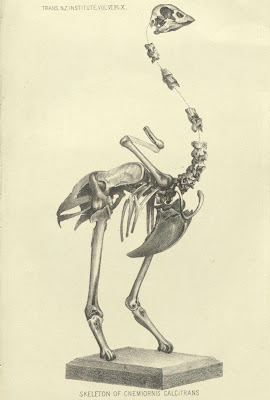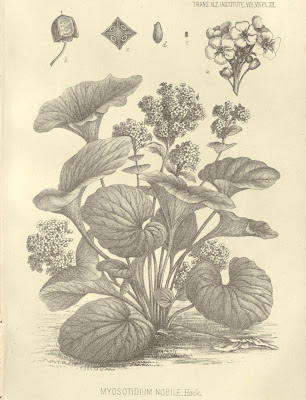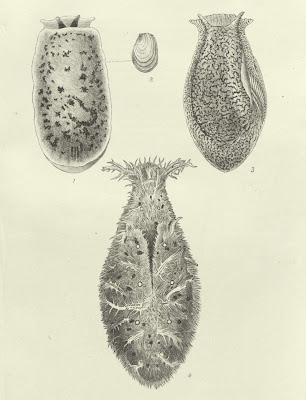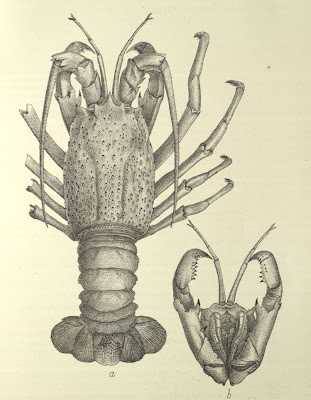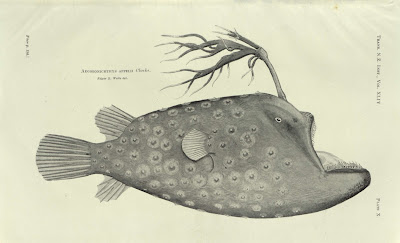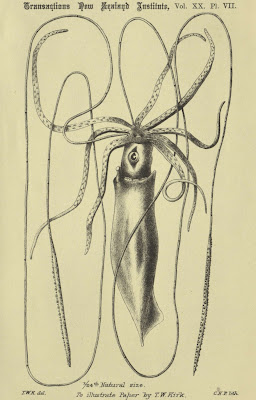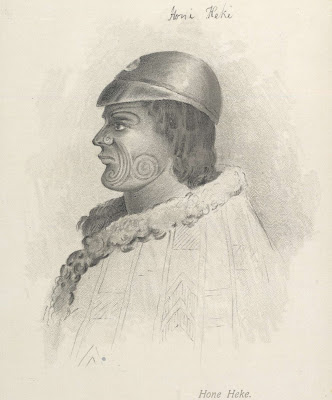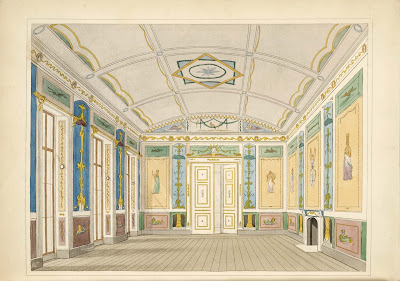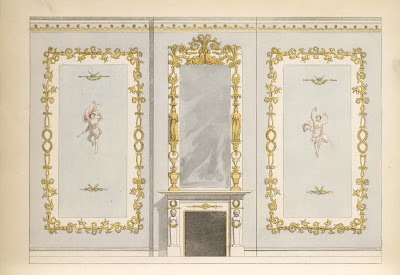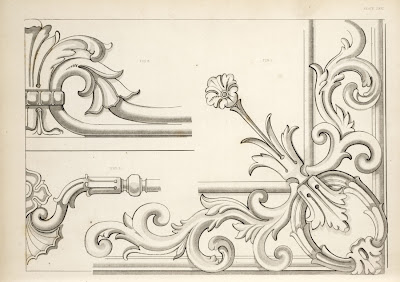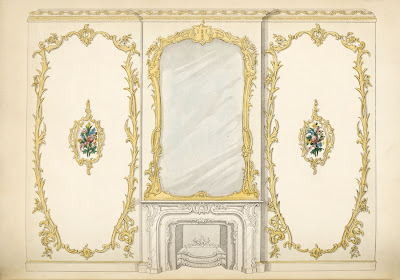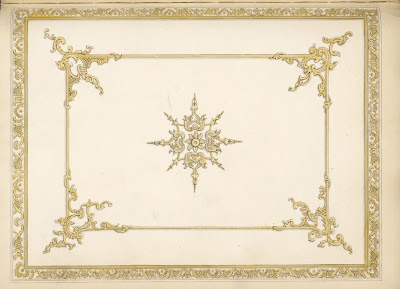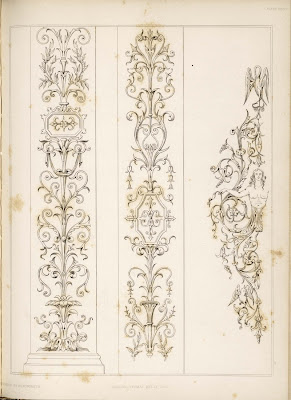
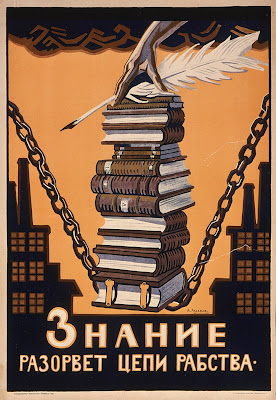
1920 print by Aleksei Radakov
(Maybe I've posted this image before? Oh well.)
(Maybe I've posted this image before? Oh well.)
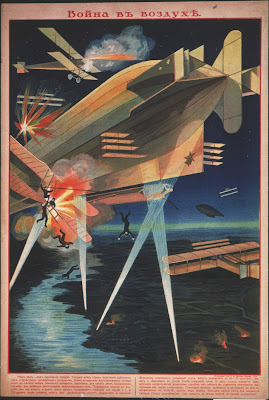
'Painting depicts aerial battle with airplanes and airships.
Text underneath describes modern aerial warfare' - 1914 lithograph.
Both from the Hoover Institution Russian Empire and Soviet Poster Collection.
Text underneath describes modern aerial warfare' - 1914 lithograph.
Both from the Hoover Institution Russian Empire and Soviet Poster Collection.

Giles Fletcher 'The history of Russia' titlepage [2nd Ed. 1643]
"This is the history of Russia before the founding of St. Petersburg ... Published originally as 'Of the Russe Common Wealth', 1591, this is the second edition of the first English book about Russia. Well more than a century before Sankt Pieter Burkh was a gleam in Peter's eye or Peter a gleam in his parents' eyes, Englishman Giles Fletcher was dispatched to Russia on a diplomatic mission to attempt to gain trade concessions for English merchants of the Muscovy Company. The indignities to which he was subjected by Russian authorities were detailed in his account written on the road home. Queen Elizabeth heard the story and registered a complaint upon which the merchants of the Company had the book suppressed, fearing the damage it could do to English/Russian trade relations. In some subsequent editions the offensive passages were removed."
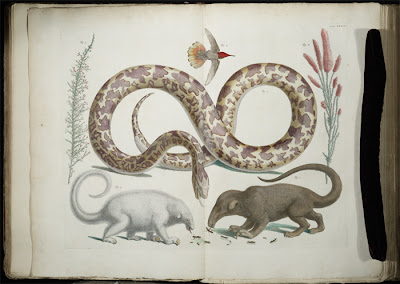
Albertus Seba, 'Locupletissimi Rerum Naturalium Thesauri' 1734-1765.
"Anteaters for the Tsar! If this New World native, the anteater, could write an account of how he made it to the Kunstkammer in Sankt Pieter Burkh in the early 18th century, it would be a best-seller. Peter the Great had begun to purchase natural history collections (birds, fishes, insects, monsters, anatomical preparations) during his pre-Petersburgian travels in the West, with an eye to the development of medicine in Russia. Albertus Seba was a wealthy Dutch apothecary, merchant and traveler whose collection of natural history objects was the largest of its kind in his day. His collection would form the nucleus of the Russian national collections in St. Petersburg after purchase by Peter."Both of the above images come from the excellent 'Frosted Windows - 300 Years of St Petersburg Through Western Eyes' exhibition site at the University of Kansas Spencer Research Library.
*Speaking of Russia: a large eclectic set of late 19th/early 20th century adverts via Ben Hayattaken.
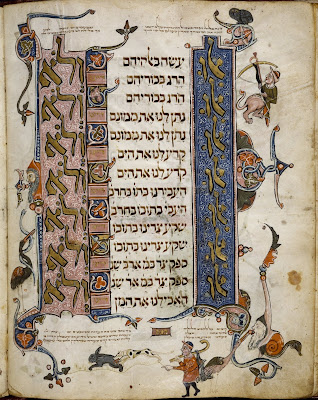
'Highly decorated text, including border decoration of a centaur
shooting at an owl and a hunter with his dog catching rabbits.'
shooting at an owl and a hunter with his dog catching rabbits.'
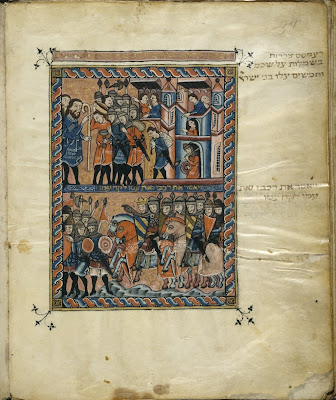
'The exodus from Rameses: Egyptians watch from windows as the
Israelites march out armed, encouraged by Moses and Aaron to
the left. Below: Pharaoh's army arrives at the Red Sea.'
Israelites march out armed, encouraged by Moses and Aaron to
the left. Below: Pharaoh's army arrives at the Red Sea.'
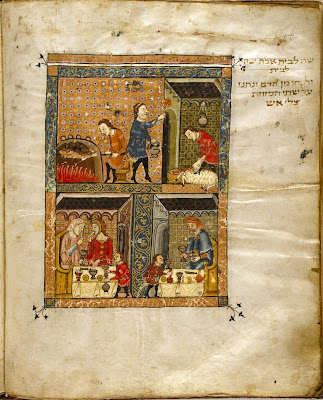
'Dining rooms and kitchens. In the kitchen a sheep in slaughtered
while a large fish is turned on a spit. A young couple eat in one
dining room while an older gentleman is served in another.'
while a large fish is turned on a spit. A young couple eat in one
dining room while an older gentleman is served in another.'

'The Parting of the Red Sea: Moses leads the Israelites across
the Red Sea, Egyptian soldiers drown in the waves.'
For no particular reason, I've always had this notion that Jewish manuscript and textual tradition was generally bereft of significant illustrations or illumination work and I guess it's fair to say that, although I've come across examples from time to time, I haven't exactly pursued the genre with any gusto. So I was happy to find these beautiful pages from a mid-13th century Haggadah from Catalonia at the University of Manchester's Rylands Library (there are no more pages online).
"The Haggadah--a compilation of biblical passages, prayers, hymns, and rabbinic literature--was probably assembled sometime during the Second Temple period in Palestine and was meant to be read during the Passover Seder, a ceremony held in Jewish homes to commemorate the Israelite redemption from Egypt in biblical times. The earliest extant version, however, appeared in a 10th century prayerbook in Babylonia. The Haggadah became a beloved and cherished text for Jews all over the world and nowhere is this high regard more evident than in the illustrations lavished on it by generations of Jewish artists from mediaeval times to the present. These illuminations represent Biblical scenes as well as scenes from rabbinic legends. Many illuminated Haggadot, most of which were produced in Europe in the middle ages, depict the preparations for the holiday and the celebration of the Seder itself thus giving us a visual image of Jewish life in earlier times."
The quote comes from 'The Passover Haggadah in the Yale University Libraries Collection' - a great exhibition site with example pages from many different manuscript and printed book forms. Thanks to D for passing on the link (months ago) - which prompted my searching out the Hebrew MS 6 at Rylands Library.

The residence of Dr. V.H. Coffman, at the corner of St. Mary's Ave. &
Sheridan St., Omaha, Nebraska IN: 'The official state atlas of Nebraska', 1885.
Sheridan St., Omaha, Nebraska IN: 'The official state atlas of Nebraska', 1885.


'Greatest number of eclipses in one year'
IN: 'Smith's illustrated astronomy' by Asa Smith, 1850.
IN: 'Smith's illustrated astronomy' by Asa Smith, 1850.

'Birds eye view of the city of San Francisco and surrounding country'.
Lithographic print by George H. Goddard, 1868. 'view looking east over ocean
beach to the city, with the East Bay and Sierra; Golden Gate at the lower left'
Lithographic print by George H. Goddard, 1868. 'view looking east over ocean
beach to the city, with the East Bay and Sierra; Golden Gate at the lower left'
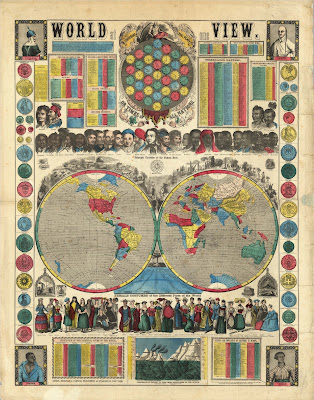
'World At One View' - broadside, 1854.
Interestingly, among the information headings in this broadside (just readable if you click and enlarge the image) is 'Great Libraries', arranged according to book numbers (better zoom views from the Rumsey site). I wondered why the Library of Congress wasn't included on the list and went off to read up on its history. I discovered that 2/3 of its 55,000 books were destroyed by a fire in 1851. The broadside was first published in 1852, prior to the collection being restored. It may just be a coincidence or perhaps the broadside publisher was a supporter of the Smithsonian Institution, the only other rival at the time to become the official national library. Read about the history at, where else, the Library of Congress.
A very significant and welcome addition to the David Rumsey Map Collection site lately was the Directory page. Now you can easily browse (by who, what, when or where) the thousands of images in the collection - not all of them are cartographic - in thumbnail views and launch a desired image into a zoomable Insightbrowser interface, a piece of web architecture I've finally decided I like. The above 5 images come from here, including the cricket which is a teeny tiny detail from a now forgotten page/book.

'The Triumph of Dionysus' by Pierre Brebiette (~1630-1640)
The National Gallery of Art in Washington have a small informative website, 'Fabulous Journeys and Faraway Places - Travels on Paper, 1450-1700' supporting a recently opened exhibition.
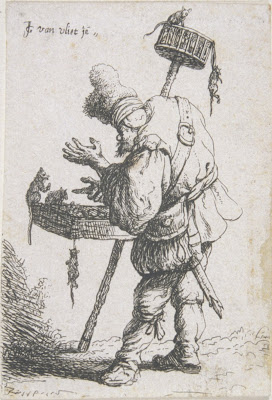
'The Rat Catcher' (~1610-1635), an etching by Johan van Vliet .
Found in the Samek Art Gallery at Pennsylvania's Bucknell University (Insightbrowser)See also: Antique rat and mouse trap gallery.

Hulgue
By sheer coincidence I went to check up the other day on an illustration project I'd known about for some time that was in part inspired by the calligraphy work of Hassan Musa (zoomorphic calligraphy) to find that an RPG book ('Reign') by Greg Stolze was just published on Lulu featuring the illustration work of Daniel Solis. See here and here. (Flickr set).
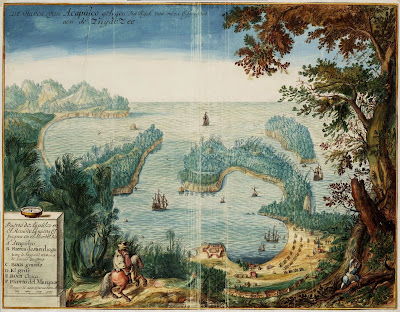
Acapulco by Johannes Vingboons, 17th century.
(spliced screencaps from the Dutch exibition site, Vitrine)
(spliced screencaps from the Dutch exibition site, Vitrine)

'View of Nieuw Amsterdam or New York' by Johannes Vingboons, 1664.
New Amsterdam had approximately 1500 residents in 1664 when it was transferred from Dutch to British stewardship, becoming New York in the process. (from the Memory of the Netherlands site)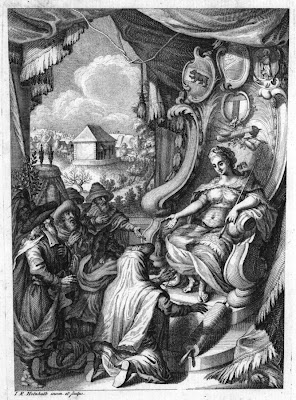
My notes say: 'History of Jews in Switzerland', from
somewhere in the Center for Jewish History digital collections.
somewhere in the Center for Jewish History digital collections.
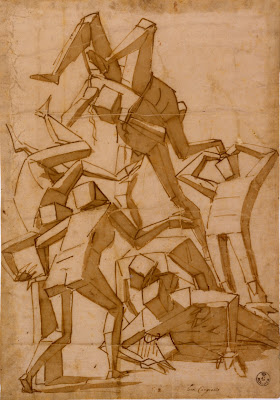
This very intriguing - almost cubist/surreal - drawing is by the Ligurian artist, Luca Cambiaso (1527-1585) and I seem to remember reading that there are several hundred other sketches by him in existence. The image was snagged from a site posted in conjunction with a current exhibition at Palazzo Ducale and Palazzo Rosso in Genoa. I recall there are multiple pages and at least the first page is in english.
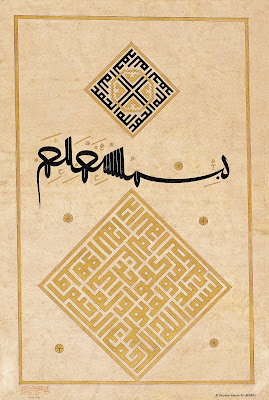
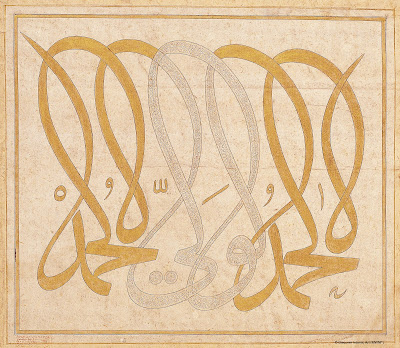
These two 16th century Ottoman-Turk calligraphy images are from the
album of Ahmed Karahisar, somewhere within the Museum With No Frontiers.
album of Ahmed Karahisar, somewhere within the Museum With No Frontiers.

'A Family Party taking an Airing'
(anonymous, 1800)
(anonymous, 1800)
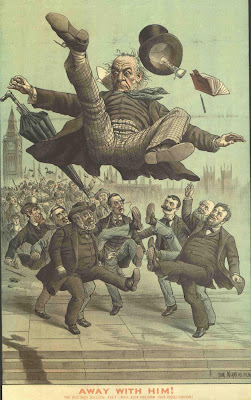
'Away with him! The wild mob's million feet will kick you from your place'
by William Mecham (aka Tom Merry), 1886.
by William Mecham (aka Tom Merry), 1886.
The University of Dublin Trinity College Nicholas K Robinson Collection of Caricature have the most annoying and pervasive watermarks and the above images took ages to approximately restore to the artists' original display. There are more than 300 images covering 1773-1900. Many appear to be British (Rowlandson, Cruikshank & co) but there are definitely some Irish prints here.


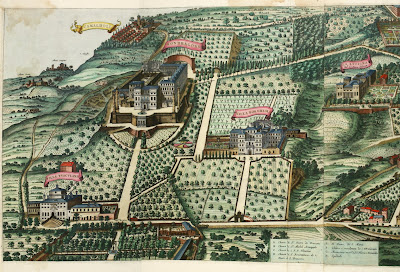
Engraved by Matthäus Greuter and printed by mapmaker Joan Blaeu in ~1620, the top image (details underneath) depicts the famed villas of the Papal nobility in the town of Frascati, just south of Rome [wikipedia have a list/links to articles/photographs of each villa]. The first free public school in Europe was opened in Frascati at about the time this engraving was made, just by the by.

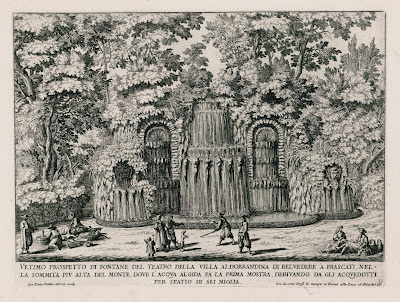

The first two baroque garden etchings above are also in Frascati ('the great water theater of the Villa Aldobrandini' and 'View of the fountain of the theater of the Villa Aldobrandini Belvedere at Frascati at the summit near the top of the mount') by Giovanni Battista Falda IN: 'The Fountains of the Villas of Frascati, or Tusculum, With Their Views', 1691. [See: Metropolitan Museum of Art: another Falda water fountain image]
The final undated image is also by GB Falda of the garden design for Prince Pamphilio's Palazzo Roma {see also Venturini image at ebay - I *think* it's the same place.}.
All the Frascati and GB Falda images were obtained from the Catena Digital Archive of Historic Gardens and Landscapes (a consortium of predominantly New York libraries).
Other things...
- I have not yet looked through the Trésors Carolingiens exhibition site at BNF - more information from the Medieval Manuscripts weblog.
- One of the best Metafilter posts in ages: Things Found in Books, from the inimitable mjj.
- 'On ya bike' - old bicycle drawings.
- Engravings and Art Materials at the Digital National Library of Serbia.
- 'Not Pop-UPs' - The Other Illustrated Books, Ephemera, and Graphic Designs of Vojtech Kubašta at Broward County Library in Florida.
- Metamorphosis - the work of 50 contemporary artists of the Surreal Art, Fantastic & Visionary art traditions from Jon Beinart and the Surreal Visionary Art Forum.
- Henrik Drescher books/illustrations.
- Dr Gale Sigal's medieval image galleries (links at the bottom: many thumbnail pages)
- When I'm in doubt about where I've found links (as in this post), there is a good chance that some came via Klaus Graf and also the mysterious bibliparis4, who is the librarian (I think) at the Sorbonne University in Paris - they both always find excellent cultural/digital material.


